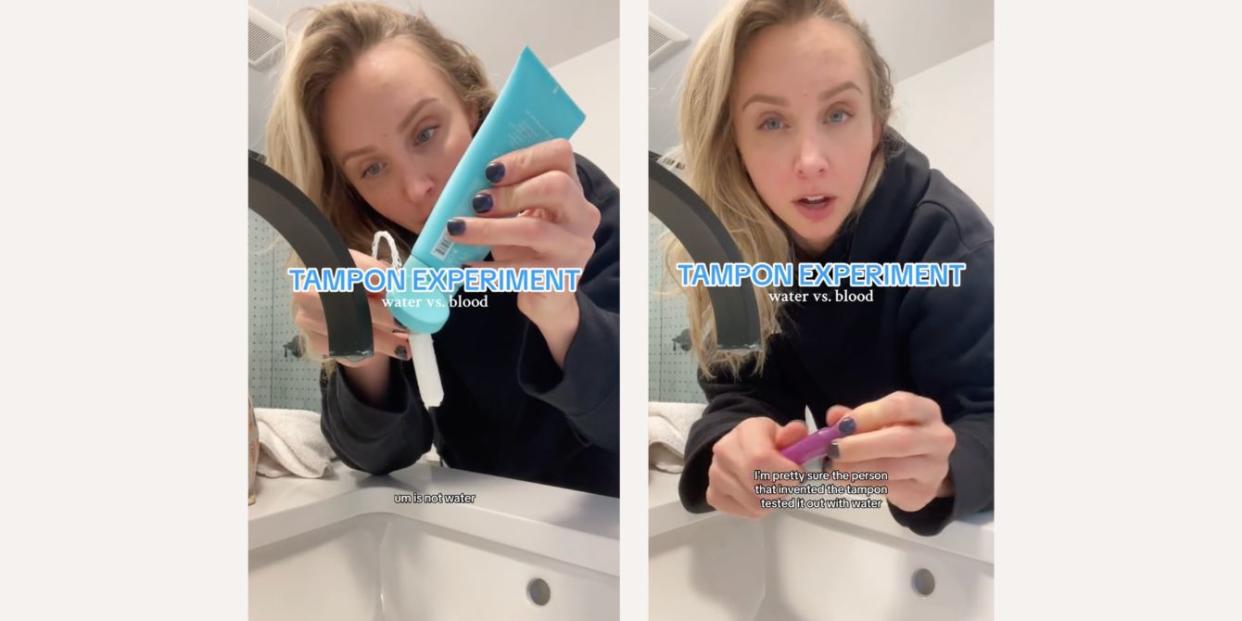Turns out, tampon companies test their products using saline and TikTok has some questions

Among the many maddening facets of the gender health gap is that women’s healthcare is seen as an afterthought, especially when it comes to research, funding, and access. So if you’ve ever leaked through an ultra-absorbent tampon and wondered what the heck is going on, you will immediately understand TikTok’s latest frustration when one mom discovered that tampon companies test their products using a saline solution.
It all started when podcaster and content creator Renee Reina conducted her very own tampon experiment, testing the absorbency of a tampon in her sink. Her findings: the tampon perfectly absorbs water, but is far less efficient at absorbing a creamy face wash, which is far closer to the consistency of period blood than literal water.
“I’m pretty sure the person that invented the tampon tested it out with water, and they were like, ‘Oh my god, it’s perfect! Oh my god!’” she jokes, as the tampon expands beneath her sink. “It was a man by the way. Now, little did they know that the consistency of blood, especially period blood, is not water.”
When the thick, creamy cleanser-like product slides right down the tampon, she says, “And, so you see that’s what’s happening inside. Just leaking right on by. All right, can we fix this? Somebody fix this.”
Not only was Reina correct — the first tampon was invented by physician Earle Haas back in 1931 — but her assessment about the faulty testing protocols was pretty spot-on, too. Turns out that lab testing for tampons has been woefully inadequate since their creation, and it was only in 2023 that they began using actual blood to test tampons.
According to an August 2023 paper published in BMJ Sexual & Reproductive Health, a team of researchers at Oregon Health & Science University found that the absorbency of many menstrual products on store shelves are mislabeled, which means they have a much lower or higher liquid capacity than advertised. Turns out, testers had been using a saline solution — a mixture of water, salt, and bicarbonate — which led to the potential inaccuracies. The researchers noted that this is the first known study to test the absorbency of period products with blood, and plenty of companies are still using saline, even after the findings were released.
“The saying ‘blood is thicker than water’ is technically true,” study co-author Samuelson Bannow told Scientific American. “We really felt that [the absorbency metric] needed to be updated.”
Aside from the obvious risk of your tampon leaking, the researchers pointed out that doctors could be missing important patient diagnoses, as a heavy period flow could be a sign of underlying health conditions, including bleeding disorders, certain types of cancer and fibroids — smooth muscle tumors in the lining of the uterus, as well as anemia.
Unfortunately, it’s not clear whether tampons will continue using real blood for testing purposes, as the researchers noted the risks associated with this process. “Frequent blood shortages in hospitals make it difficult to justify using donations for anything other than transfusions. The fluid is also considered a potential biohazard. Researchers who handle blood in the lab must undergo training and take special precautions to work with it safely,” they said.
It’s also cost-prohibitive, which certainly doesn’t help in an arena that’s already woefully underfunded. The study notes that a 10-ml vial of research-quality human blood costs around $100. Even more costly is high-quality synthetic blood — 200 ml of a lab-made mixture of amino acids and hemoglobin can run upward of $150. Labs can buy a full liter of saline solution for just $45.
So, no, it’s not just you: your tampons aren’t necessarily up to snuff, and it’s equal parts unsurprising and annoying as all get out.

